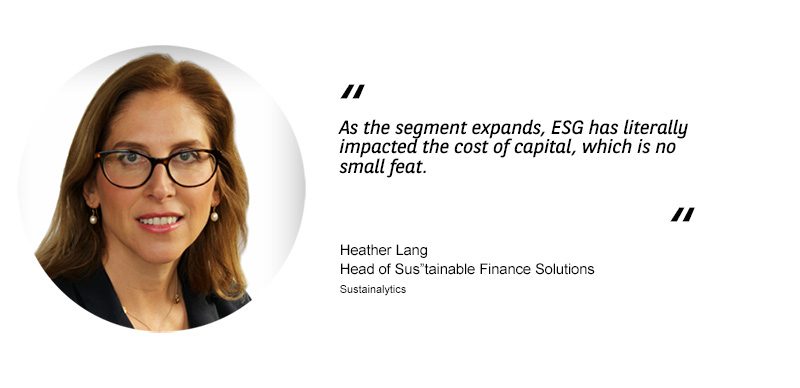As
the sustainable finance continues to mature into a core element of the
financial services industry, investors and companies are contemplating a new
framework for credit ratings and environment, social and governance (ESG)
scores. What do these scores represent and how are they formulated? What does
the future hold for such metrics? Ultimately, what impact will ESG have on a
company’s capital raising?
These
are just a few questions that were explored at BNP Paribas’ recent installment
of its Sustainable Future Online Series. The virtual event was moderated by Hervé
Duteil, Chief Sustainability Officer for the Americas at BNP Paribas, and the
program featured experts from leading ratings and research agencies Fitch and
Sustainalytics, whose differentiated approach provided a well-rounded and
informed discussion about the world of credit ratings and ESG scores.
Tailored Ratings
Kicking
off the discussion, Heather Lang, Head of Sustainable Finance Solutions at
Sustainalytics, noted that her firm has consistently modified its approach to
ESG scoring development over time to reflect changing market dynamics. “This
has included emphasizing areas like risk alongside preparedness and
performance,” said Lang. Client demand has helped shape product offerings
during this time, added Lang. “Our flagship ESG rating released in 2018 has an
explicit focus on materiality, which was in large part derived from client
feedback,” she said.
Andrew
Steel, Managing Director and Global Group Head of Sustainable Finance at Fitch,
indicated a desire among clients to understand which elements of ESG were most
relevant from a credit standpoint, as well as how the company came to that
determination. “This has informed our effort to bring even greater transparency
to bear, so that investors could clearly see how risk factors influenced our
decision-making process,” he said. Accordingly, every entity or transaction
reviewed by Fitch comes with its own unique set of ESG relevance scores,
covering a forward-looking period of two to give years. The scores also
identify which elements of ESG risk impacted the rating decision. Fitch has created 96 sector-based templates
across its asset classes, which identify specific ESG credit risks that are
relevant to issuers or transactions for a standardized set of general ESG risk
issues.

Steel
commented that if an issuer’s activity was ESG ‘friendly’ it did not
necessarily mean that it would convey a credit benefit. He gave the example of two identical windfarm
electricity generators – one that sold its electricity into a merchant market
and one that sold its electricity under a tariff framework. Steel emphasized that despite being a 100
percent renewable producer of electricity, the producer selling into a merchant
market would likely experience a negative impact on its credit profile, as it
would be a pure price taker, given the intermittent and unpredictable nature of
wind generation. This could make its
credit profile less attractive than a thermal generator in the same market
position. However, for the producer that
benefitted from a guaranteed offtake and pre-agreed tariff mechanism, the
impact from being a wind farm generator could be credit positive. “In short,
you need to be very careful about making generalizations around ESG risks and
weightings, which are very much specific to individual businesses and financial
profiles,” said Steel.
For
its part, Sustainalytics utilizes publicly available data such as financial
filings and sustainability reporting for its research, augmenting with credible
media sources and third-party data providers. “Companies are then asked to
provide feedback prior to publishing,” explains Lang, “and it is worth noting
that the level of responsiveness has increased over the years, as ESG has become
more prominent.”
Fitch
employs a one-to-five rating scale to assess ESG relevance and materiality by
company across 14 or 15 general ESG risk issue categories. Lower scores indicate no impact on credit
within a given sector, while higher numbers (four or five) indicate material
credit impact, with a score of five indicating an ESG issue that is
unambiguously changing the current rating. “In this case the analyst would articulate to what degree the credit
rating has been affected due to any ESG risk factors,” said Steel.
Widening Appeal to Investors and Issuers
Asset
managers as well as some owners have long relied on ratings to make informed
decisions, noted Lang. While institutional investors have typically been equity
focused, in recent years the shift toward a more integrated, enterprise-wide
usage of ESG has driven interest in other asset classes. Fixed income
investors, for example, have been increasingly leveraging ESG factors to assess
credit risk, bond selection and related activity. “Lenders have also used our
ratings to identify potential ESG risk among borrowers, and some have begun
linking interest rates to our ratings as performance targets for sustainability
linked loans,” said Lang.
Steel
has seen growing demand among asset owners to boost reporting around ESG as it
relates to the investment portfolio. “There are those investors who’ve already
integrated the concept and essentially won’t commit any capital without a
complete ESG assessment process in place,” said Steel. “Some less sophisticated
smaller or medium-sized investors are only now coming to terms with ESG. It’s
that latter group that has informed our integrational approach, which we felt
was the best way to introduce investors to the credit-specific aspects of ESG.
[Our approach] gives investors a benchmark that shows the relative impact of
ESG across a number of asset classes, from structured finance to corporates and
beyond.”
A Look Ahead
As credit is likely to remain under pressure globally due to covid-19, ESG has a unique opportunity to prove its worth around credit scores over the coming quarters.
“When the crisis began, most of our issuers switched into liquidity management mode,” said Steel, “however since that time the imposition of cross-country barriers has sparked more interest in the integrity of supply chains, which is something we believe is ripe for ESG analysis.”

Whether
or not the pandemic could slow ESG momentum is something that remains to be
seen. “There have been plenty of positive signs, such as South Korea restating
its commitment to green recovery and the EU outlining conditions around green
support funding,” said Steel. “However, the need to fund current priority areas
like healthcare systems could lead to fewer renewable subsidies or, in certain
regions, even some relaxation of green standards,” he added.
Lang
believes the social component of ESG will continue to gain traction, due in
part to the impact of COVID-19. “Looking more broadly beyond credit ratings,
we’ve seen a majority of ESG funds outperforming the market during the crisis,”
said Lang. Data from Morningstar (which recently acquired Sustainalytics) shows
ESG assets reaching a record US$12.2bn through the first four months of 2020,
roughly twice as much as the year-ago period. Given that ESG funds have
historically fared better in down markets, observers like Lang remain sanguine
over the near term.
“I
think that the industry consolidation and regulatory change we’ve seen of late
shows that ESG matters—that investors really do value this approach,” said
Lang. “As the segment expands, ESG has literally impacted the cost of capital,
which is no small feat. Accordingly, we expect ESG to show continued resilience
moving forward.”
